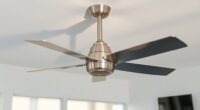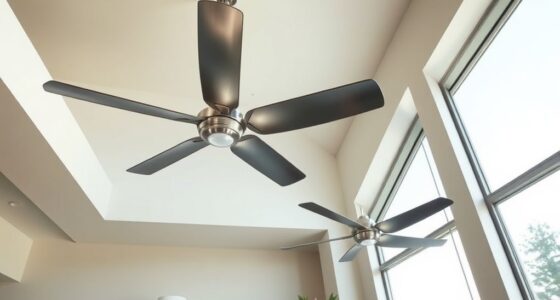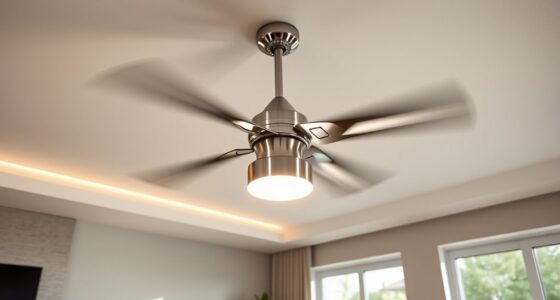Choosing the right fan size for a small room depends on measuring your space accurately and understanding airflow needs. Look for fans with appropriate CFM ratings—higher for better circulation—and make certain the motor power matches your room’s size. Selecting styles with features like quiet operation and good lighting can boost comfort. Proper placement, along with considering ventilation options beyond fans, helps optimize airflow. Keep exploring to discover more tips for perfect fan sizing and ventilation.
Key Takeaways
- Measure your room’s dimensions accurately to select a ceiling fan with an appropriate blade span, typically 29-36 inches for small spaces.
- Ensure the fan’s CFM rating matches your room size to provide adequate airflow and ventilation.
- Choose fans with energy-efficient motors and ENERGY STAR certification to optimize performance and reduce energy costs.
- Consider fan features like quiet operation and style to enhance comfort and match your room decor.
- Use ventilation strategies beyond fans, such as natural airflow and exhaust systems, for comprehensive air quality management.
Understanding Room Size and Its Impact on Fan Selection
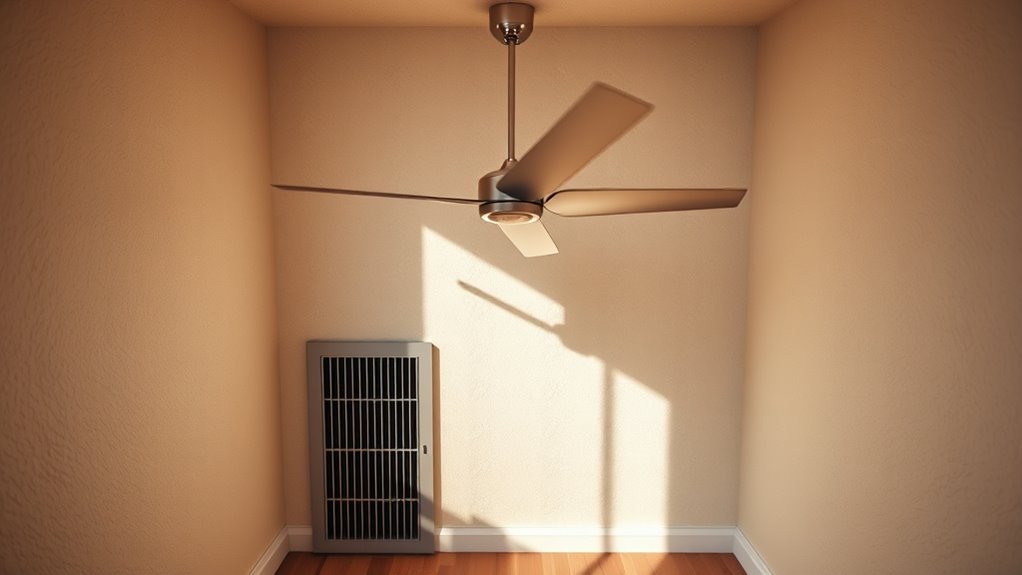
Understanding the size of your room is essential when choosing the right fan. The room dimensions directly influence how effectively a fan can promote air circulation. A small space requires a fan that can move air efficiently without overwhelming the room or causing noise. If your room is compact, a smaller fan with lower power might be enough to circulate air evenly. Conversely, larger rooms need fans that can handle greater space, ensuring proper ventilation. Knowing your room’s size helps you avoid under- or over-sizing your fan, which can lead to insufficient airflow or unnecessary energy use. Measure your space carefully, including height, width, and length, to select a fan that complements your room’s dimensions and maintains comfortable air movement. Additionally, understanding fan sizing principles ensures optimal performance and energy efficiency.
The Importance of CFM: How to Measure Your Fan’s Power
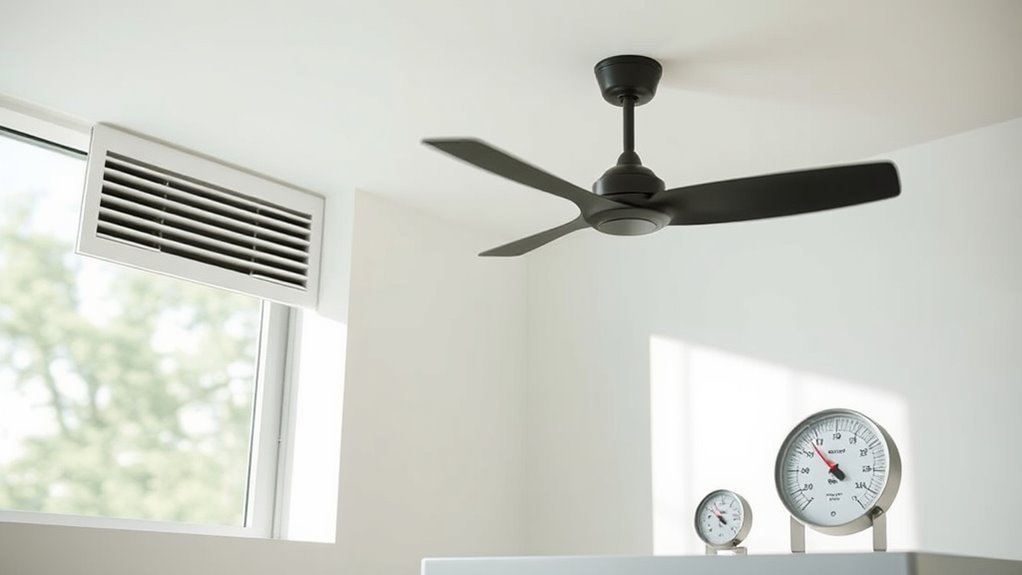
To guarantee your fan effectively circulates air, paying attention to its CFM rating is crucial. CFM, or cubic feet per minute, measures airflow efficiency, indicating how much air the fan moves each minute. A higher CFM means better airflow, which is essential for small rooms where proper ventilation matters. When evaluating fans, consider the fan motor’s power, as it directly impacts CFM output. A strong motor ensures consistent airflow without straining, maintaining efficiency over time. Accurate CFM measurement helps you choose a fan that matches your room size and ventilation needs, preventing underperformance or energy waste. Additionally, understanding Angel Numbers can provide insight into energy and love balance in your space. Remember, a well-measured CFM ensures your fan delivers optimal circulation, keeping your space comfortable and well-ventilated.
Ceiling Fan Styles and Features That Enhance Comfort
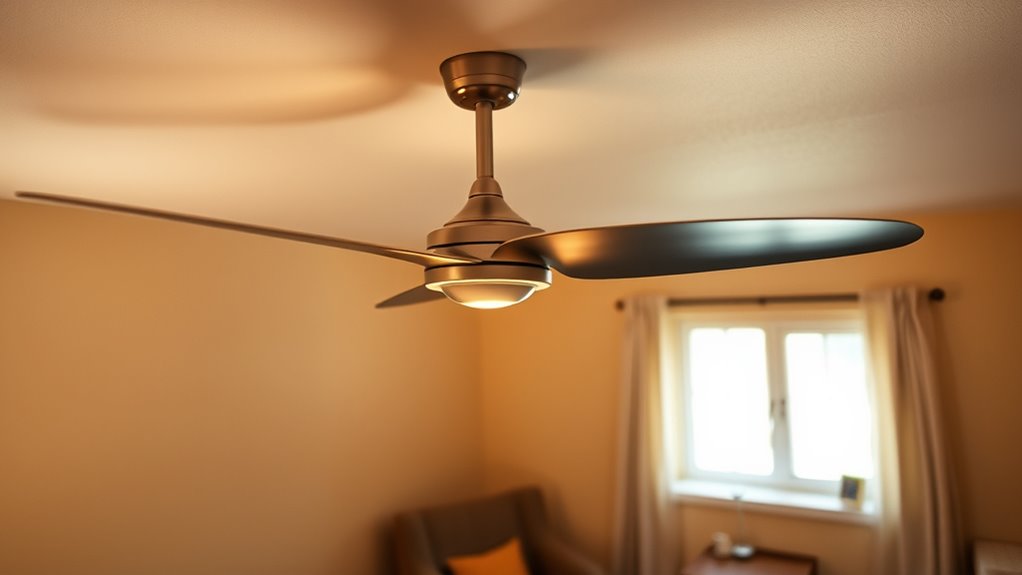
Choosing the right ceiling fan style and features can considerably boost your comfort in a small room. Decorative fan styles, from sleek modern designs to vintage-inspired looks, can complement your decor while improving airflow. Smart ceiling fan features add convenience, allowing you to control fan speed, lighting, and even set schedules via smartphone or voice commands. These features can optimize comfort based on your preferences and climate conditions. Additionally, selecting fans with good lighting options can further enhance the functionality and ambiance of your space.
Ventilation Options Beyond Fans: When and Why to Consider Them
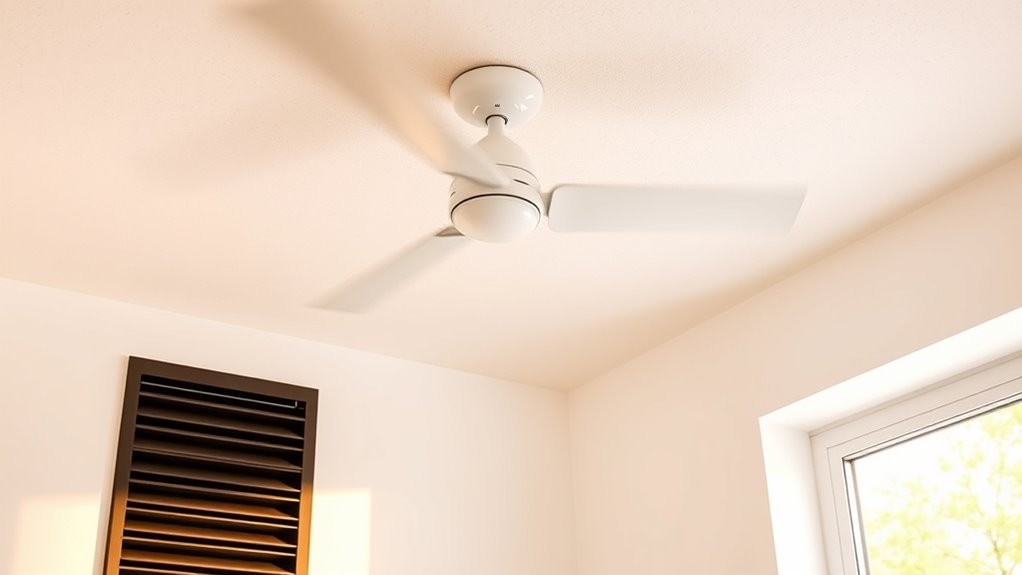
While selecting the right ceiling fan can improve airflow and comfort, there are situations when additional ventilation methods become necessary. If you notice persistent odors, high humidity, or poor air quality, consider alternatives. Here are four options to explore:
Sometimes fans aren’t enough; explore natural, filtered, or mechanical ventilation to improve air quality.
- Natural ventilation—open windows or vents to bring in fresh air and reduce reliance on fans.
- Air purification systems—use filters or purifiers to remove pollutants and improve indoor air quality.
- Exhaust fans—install in kitchens or bathrooms to vent moisture and odors directly outside.
- Mechanical ventilation—consider HRV or ERV systems for continuous air exchange, especially in tightly sealed spaces.
These methods can complement fans, ensuring healthier, more comfortable environments when fans alone aren’t enough.
Common Mistakes to Avoid When Sizing Fans for Small Spaces
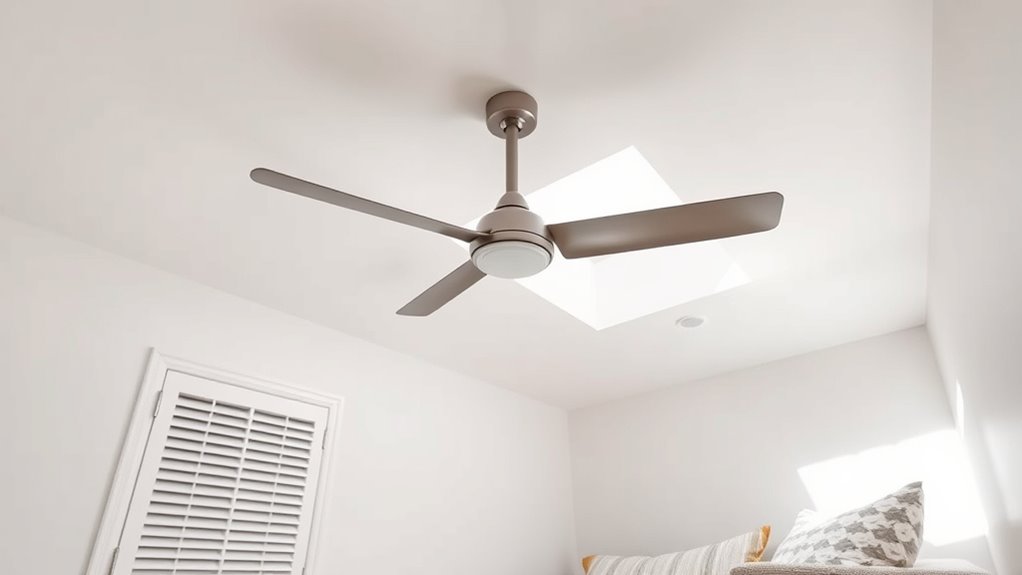
Selecting the right fan size for a small space might seem straightforward, but many people make common mistakes that can compromise airflow and comfort. One mistake is ignoring the fan material, which affects durability and noise levels; choosing lightweight or cheap materials can lead to vibrations and rattling. Another mistake is overlooking remote controls; skipping this feature can make it difficult to adjust settings easily, especially in tight spaces. Additionally, some underestimate the importance of proper sizing, opting for too small or too large fans, which can cause uneven airflow or excess noise. Failing to take into account these factors can leave your space uncomfortable and inefficient. Proper consideration of fan motor quality can significantly impact the longevity and operation of your ventilation system. Avoid these pitfalls to ensure your fan provides ideal ventilation, comfort, and convenience.
Tips for Proper Fan Placement for Maximum Efficiency

To get the most out of your fan, pay attention to its height and placement in the room. Position the fan at an ideal height to maximize airflow without causing discomfort. Additionally, place it strategically to ensure even coverage and avoid blockages that can reduce efficiency. Proper placement can also help in air circulation and improve overall ventilation performance.
Optimal Fan Height
Have you ever wondered why fan placement dramatically impacts its efficiency? The key is finding the right fan height. Proper placement ensures ideal airflow and comfort. Here are tips to achieve the best fan height:
- Maintain at least 7-9 feet of ceiling clearance to prevent wobbling and noise.
- Position the fan so the blades are 8-9 feet above the floor for maximum circulation.
- Avoid hanging the fan too low, which can obstruct movement or create a safety hazard.
- For sloped ceilings, use downrods to adjust fan height to maintain proper clearance and airflow direction.
- Ensuring the fan blades are free of discoloration and separation enhances performance and safety.
Getting the fan height right ensures efficient cooling and ventilation, especially in small rooms where airflow matters most.
Strategic Room Positioning
Proper fan placement is essential for maximizing airflow and cooling efficiency in small rooms. To optimize airflow patterns, position your fan where it can circulate air evenly across the space. Typically, ceiling fans should be installed near the center of the room, ensuring the blades are at the recommended height for effective air movement. Avoid placing fans near walls or furniture that can disrupt airflow patterns. For oscillating or portable fans, direct airflow toward the center of the room rather than into corners or obstructed areas. Proper fan placement minimizes stagnant air pockets and enhances overall comfort. Remember, strategic positioning ensures the fan works efficiently, providing maximum cooling with less energy consumption. Taking the time to find the ideal spot makes a noticeable difference in your room’s airflow dynamics, especially when considering vertical storage solutions to keep the space organized and free of clutter.
How to Balance Noise Levels and Energy Consumption
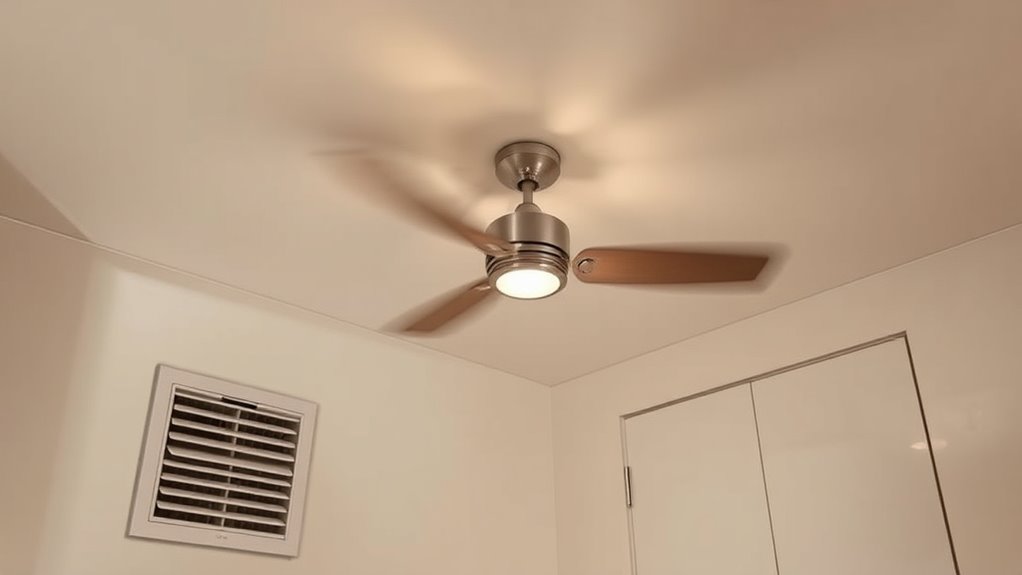
Balancing noise levels and energy consumption when choosing a small room fan requires careful consideration of both factors. To minimize sound disturbances and maximize energy efficiency, focus on these key points:
- Opt for fans with sound insulation features to reduce noise without sacrificing airflow.
- Select models with adjustable speed settings, allowing you to limit energy use during quieter periods.
- Prioritize energy-efficient fans that meet ENERGY STAR standards to lower power consumption.
- Regularly maintain your fan, cleaning blades and ensuring proper installation, which helps reduce noise and improves efficiency.
- Understanding the father-daughter bond can inspire you to choose a fan that brings comfort and harmony to your space.
Frequently Asked Questions
How Does Ceiling Height Affect Fan Effectiveness in Small Rooms?
Higher ceilings can diminish a ceiling fan’s effectiveness in small rooms since the air circulation may not reach you directly. To counter this, consider ceiling height considerations and fan placement strategies like installing downrods to lower the fan or placing it closer to the room’s center. This ensures better airflow, keeps the space comfortable, and maximizes your fan’s performance regardless of ceiling height.
Can Smart Fans Improve Ventilation in Compact Spaces?
Imagine your room’s ventilation as a scene from a noir film—smart fans are the detectives, quietly improving airflow. Yes, they can boost ventilation in compact spaces by intelligently adjusting speed and direction. With smart technology, you gain energy efficiency and precise control, ensuring your small room stays comfortable without wasting power. These fans optimize air circulation, making them a modern solution to traditional ventilation challenges.
What Are the Best Materials for Small Room Ceiling Fans?
You should choose ceiling fans with blade materials like wood or composite for durability and aesthetic appeal. Metal blades are sturdy but may be noisier, while plastic blades are lightweight and budget-friendly. Also, consider the motor’s endurance; a high-quality motor ensures longer life and smoother operation in small rooms. Combining these materials and motor quality helps you find a fan that lasts and performs well in compact spaces.
Are There Eco-Friendly Options for Small Space Fans?
You’ll find eco-friendly options for small space fans, including solar-powered models and energy-efficient designs. Solar options harness sunlight to run your fan, reducing electricity use, while energy-efficient models consume less power without sacrificing performance. Look for fans with Energy Star certification or those made from sustainable materials. These choices help lower your carbon footprint and save on energy bills, making your home greener and more sustainable.
How Often Should I Maintain or Clean My Small Room Fan?
You should clean your small room fan every 1 to 2 months to keep it running efficiently. Focus on fan blade maintenance by removing dust and debris, which can accumulate quickly. Regular cleaning frequency prevents buildup that can cause noise or reduce airflow. Use a damp cloth or gentle brush to clean the blades thoroughly, and don’t forget to turn off the fan before cleaning to stay safe.
Conclusion
Choosing the right fan for your small room can seem tricky, but it’s worth the effort for comfort and efficiency. Don’t worry—by considering your space size, CFM, and placement, you’ll find the perfect fit. Some might think fans are unnecessary in small rooms, but proper ventilation improves air quality and saves energy. Trust the process, and you’ll enjoy a cooler, more comfortable space without the noise or high costs you fear.

